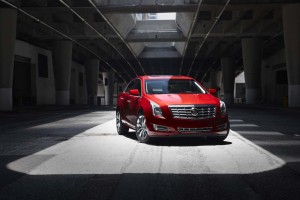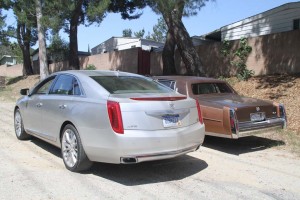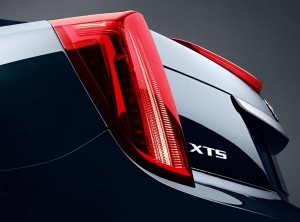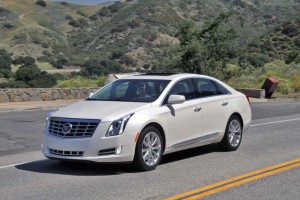The new 2013 Cadillac XTS is off to a shaky start – but that’s good news. Cadillac’s big new sedan is introducing a variety of new high-tech features, including a “Driver Awareness Package” that vibrates the driver’s seat to signal when there’s a potential problem ahead.
Ostensibly, the new XTS replaces the aged and largely unloved Cadillac STS and DTS models and is meant to better position the brand against the likes of the BMW 5-Series, Audi A6 and Mercedes-Benz E-Class. The Detroit maker has stopped using the word, “flagship” to describe the new sedan, a subtle clue that an even more lavish premium-luxury model based loosely on the Ciel concept car is in the works. But flagship or not, the XTS is going to be one very important entry into the 2013 Cadillac line-up.
Along with the new compact ATS sedan – Caddy’s new 3-Series fighter – the bigger XTS will help flesh out what has been a relatively thin range of products. And it should help position the one-time global luxury leader as ripe for a renaissance, as Cadillac executives like to call it.
But is the 2013 Cadillac XTS the right car to take on such a heavy load?
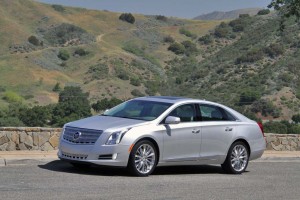
There are no plans - for now, anyway - to offer an XTS-V but Caddy is adding a heavily contended XTS Platinum model.
Some purists will gripe that the XTS is the only front-drive model in the Caddy sedan spectrum. The General Motors brand largely walked away from front-drive when it developed a rear-drive platform – which also could be offered in all-wheel-drive layout – for the original CTS. That was later shared on the STS and original SRX crossover.
The new SRX has migrated to an alternative “architecture” and so has the new XTS, which shares many of its underpinnings with the less aggressive and up-market Buick LaCrosse. But thanks to the use of Brembo brakes and GM’s Magnetic Ride Control system, the new Caddy delivers some reasonable performance and handling credentials, even if it’s not quite up to the sportiest of its European competition.
Like the CTS, the new Cadillac XTS makes use of the brand’s “Art & Science” design language. It’s not quite as edgy as the smaller sedan – which is quite fine. The XTS needs to be a bit more refined and sophisticated, yet a drive through normally import-oriented Southern California found that the sedan turned plenty of heads wherever we went, whether we pulled up along an Aston Martin or a beat-up old pickup.
The egg crate grille and vertical headlamps flows smoothly into a well-sculpted hood. The roofline adopts a somewhat coupe-like curve, apparently a requirement in today’s luxury market. A strong character line flows from the front doors back into the signature upright taillamps, the XTS featuring just the merest hint of the fins that once defined Cadillac when it could proudly boast of being “standard of the world.”
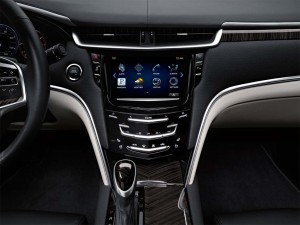
The new voice and touch-operated Cadillac CUE system may be the market's easiest-to-use infotainment system.
The interior is without question to most elegantly executed cabin we’ve seen since the days when Cadillac truly was king-of-the-hill. Our top-line Platinum Edition was lavishly finished in sumptuous leathers and accented with just the right touch of leather and wood. The XTS Platinum is the first Cadillac to adopt Alcantara, that rich suede-like material, though it is limited to the headliner.
The gauge cluster is a particular eye-catcher. It is, in fact, a large reconfigurable display that can, with the touch of a button, switch between a host of different digital gauge layouts. It is a notably better execution than that found in the Jaguar XJ.
But what is generating the biggest buzz is the Cadillac CUE system. If you’re familiar with the Apple iPhone’s new Siri technology you already have a good understanding of what it can do. In fact, it uses some of the underlying Siri software code. Where traditional automotive infotainment systems require a user to learn very rigid commands, CUE lets you speak in a natural voice, say, “Pair my phone,” or “connect my phone,” or even “hook up my phone.”
The new CUE system also adopts an iPhone like display that adds haptic – or tactile – feeback. Touch the screen to switch radio stations, for example, and it subtly vibrates. Many of the controls work like an iPhone, in fact, allowing you to slide a finger to raise the audio volume. No wonder Caddy is giving an Apple iPad to XTS buyers. The tablet computer will be pre-loaded with several apps, including one that allows a driver to practice working with CUE.
On the downside, it can be a bit awkward to use some of the CUE system’s manual controls on a rough road.
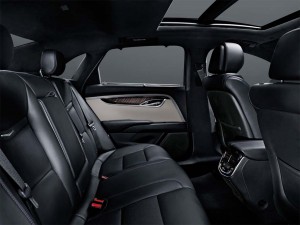
Though actually lighter than the Cadillac CTS, the new XTS is about 12 inches longer, meaning a roomy rear seat.
Then there’s the seat-shaker. The 2013 Cadillac XTS adopts a wide range of optional or standard safety features, including forward collision warning and lane departure warning. If you inadvertently start drifting into an adjacent lane the seat will vibrate on that side. If you’re approaching oncoming traffic too fast the entire seat will shake.
That technology might not satisfy everyone so Cadillac does allow you to shut it off.
The interior of the new XTS is big enough that Caddy has no plans to offer an extended wheelbase version, even in China, where BMW and a number of other luxury makers have had to introduce stretch models. The 2013 Cadillac is a full 12 inches longer than the CTS – and about eight inches longer, but an inch narrower, than the Audi A6.
But what’s absolutely surprising is that it’s also about 100 pounds lighter, curbweight ranging from 4,100 to 4,300 pounds depending upon options and whether you’ve opted for front or all-wheel-drive.
That so-called “lightweighting” is something we noticed immediately as we wound our way out of L.A. traffic and headed into the forested mountain roads north of the City of Angels.
Even in FWD configuration the new Cadillac XTS maintains a solid grip on the road. It’s even more precise with the all-wheel package. The Magnetic Ride Control system uses a fluid largely comprised of ferrous particles that change their ability to flow depending on how much magnetic current you apply. That allows road sensors on the car to change the firmness of the suspension thousands of times a second.
The other element that helps is a surprisingly supple electric power-assist steering, or E-PAS system. You’re not going to find quite the firmness, nor the subtle shift in feedback as you enter a tight corner with a BMW 5-er, but the XTS steering will pleasantly surprise those familiar with more traditional American luxury cars.
Rounding things out, Cadillac has equipped the XTS with the same basic Brembo brakes found in the CTS-V model.
Don Butler, Cadillac’s chief of marketing, says there are no plans to offer a V-Series version of the XTS. Instead, the maker will stick with the more plush Platinum. While that’s a bit of a disappointment, the new sedan’s 3.6-liter V-6 is no slouch at 304 horsepower and 264 lb-ft of torque. Off-the-line acceleration is enhanced by the way Caddy engineers were able to hold down the weight of the new sedan.
That also means better fuel economy, the FWD version of the new sedan getting 17 mpg City, 28 Highway, 21 Combined, according to the EPA. For the AWD version of the Cadillac XTS that dips ever –so-slightly to 17/27/20.
If we have one big complaint it’s with the programming of the 6-speed XTS automatic gearbox. The sedan can be shifted into Sport Mode, but that doesn’t really impact the way the car shifts, if that doesn’t confuse you. While Sport Mode tightens up steering and suspension the gearbox behavior is unaffected. Launching up some of the steeper hills along Mulholland Drive we found ourselves waiting in frustration, accelerator pedal to the floor, for a requested double-downshift.
Cadillac officials heard that complaint repeatedly during a recent series of media drives and we can only hope they will respond by reprogramming the gearbox in a hurry, or perhaps giving the XTS a more competitive seven or even eight-speed, much like many of its competitors.
In fact, we wouldn’t be surprised to see some other revisions to come. While the formal response is, no, there won’t be an XTS-V, we’re not so sure. Or, perhaps, we’ll just see another engine option based on some very off-the-record comments we heard during our two days in L.A. Even a hybrid option appears to be in the consideration stage, if not under active development.
While there are a few complaints, they should not come as the dominant takeaway. The XTS is a huge improvement over Cadillac’s two outgoing large cars. The DTS was an outdated dud and the STS never quite lived up to expectations, inside or out. If there’s any disappointment, it’s that the 2013 model isn’t quite up to what it will take to serve as a true Cadillac flagship – which is why brand executives appear to have suddenly banished that term from their vocabulary. We’ll have to wait for the production spin-off of the Ciel, which will likely show up sometime in 2014, using another all-new rear-drive architecture known inside GM as Omega.
But the 2013 Cadillac XTS is a clear step forward. It returns the GM luxury marque to the big car segment where it has been all but forgotten. And it does it with style, reasonable performance and handling and plenty of breakthrough technology. If this is any indication of where Cadillac is heading, it’s a very good sign, indeed.

